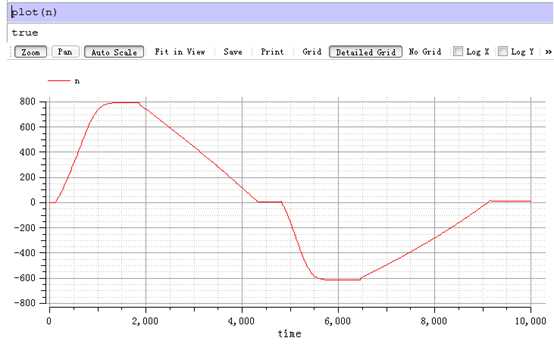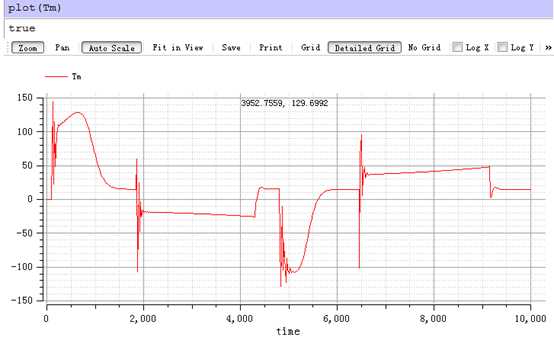标签:
第四周作业
这周复习了第四章中三相异步电动机的工作原理及其机械特性,以此为依据巩固了三相异步电机的启动、调速及制动。
这周课外比赛的琐事较多,没有额外增加阅读内容。
?
仿真作业
基本要求:
结合本周学习的交流电机原理及启动、调速、制动特性,用Modelica设计和仿真一个用三相交流异步电机带动起重机起升机构运行。具体要求如下:
1)实现如下机械运动周期:
2) 升降机构和重物折算到到电机转子轴上的等效负载惯量为1Kg.m^2,折算到到电机转子轴上的等效负载转矩是15N.m。
3)使用统一的电机模型,如果控制策略中用到转子串电阻,允许将该电机的转子改为绕线式转子(参数不变)。
4)参照教材中给出的交流电机启动、调速和制动方法,设计控制策略,用Modelica实现控制策略并与电机模型实现联合仿真。
5)可以采用定子串电阻、转子串电阻、定子调压、定子调频等手段,但必须具备工程上的可实施性。
6)评价指标:快速启动、制动,冲击转矩和冲击电流小,能耗小,兼顾实施的经济性。
7)方案最佳同学获本周"控制之星"称号。
?
仿真过程:
首先调整了负载惯量值,同时,考虑到启动时转矩不能过大,根据书中所述异步电动机固有机械特性,当施加在定子每相绕组上的电压降低时,启动转矩会明显减小,当转子电阻适当增大时,启动转矩会增大,启动时采取降压启动。
制动时,为追求效率,采用反接制动,由于反接制动时电流很大,所以酌情在定子电路中串接附加电阻。
调整转速时,根据
可知转速变化的比率与频率及电压的变化率相同,电机原模型转速1500 r/min,通过调整频率f及电压可以实现调速。
设定速度为800 r/min 时,注意到直接乘系数 800/1500 不能得到最终稳定切合800 r/min 速度的曲线,由于额定转速 ,取系数 800/(1500*0.985),结果曲线良好。但对于反向600 r/min 的速度,调整效果劣于原数值,故直接取系数 600/1500 。
停止部分,由于电机仍受15 N.m 转矩,因此仍需设定一不大的频率及电压值。
?
?
代码如下:
model SACIM "A Simple AC Induction Motor Model"
type Voltage=Real(unit="V");
type Current=Real(unit="A");
type Resistance=Real(unit="Ohm");
type Inductance=Real(unit="H");
type Speed=Real(unit="r/min");
type Torque=Real(unit="N.m");
type Inertia=Real(unit="kg.m^2");
type Frequency=Real(unit="Hz");
type Flux=Real(unit="Wb");
type Angle=Real(unit="rad");
type AngularVelocity=Real(unit="rad/s");
?
constant Real Pi = 3.1415926;
?
Current i_A"A Phase Current of Stator";
Current i_B"B Phase Current of Stator";
Current i_C"C Phase Current of Stator";
Voltage u_A"A Phase Voltage of Stator";
Voltage u_B"B Phase Voltage of Stator";
Voltage u_C"C Phase Voltage of Stator";
Current i_a"A Phase Current of Rotor";
Current i_b"B Phase Current of Rotor";
Current i_c"C Phase Current of Rotor";
Frequency f_s"Frequency of Stator";
Torque Tm"Torque of the Motor";
Speed n"Speed of the Motor";
Resistance Rs"Stator Resistance";
?
Flux Psi_A"A Phase Flux-Linkage of Stator";
Flux Psi_B"B Phase Flux-Linkage of Stator";
Flux Psi_C"C Phase Flux-Linkage of Stator";
Flux Psi_a"a Phase Flux-Linkage of Rotor";
Flux Psi_b"b Phase Flux-Linkage of Rotor";
Flux Psi_c"c Phase Flux-Linkage of Rotor";
?
Angle phi"Electrical Angle of Rotor";
Angle phi_m"Mechnical Angle of Rotor";
AngularVelocity w"Angular Velocity of Rotor";
?
Torque Tl"Load Torque";
?
parameter Resistance Rr = 0.408"Rotor Resistance";
parameter Inductance Ls = 0.00252"Stator Leakage Inductance";
parameter Inductance Lr = 0.00252"Rotor Leakage Inductance";
parameter Inductance Lm = 0.00847"Mutual Inductance";
parameter Frequency f_N = 50"Rated Frequency of Stator";
parameter Voltage u_N = 220"Rated Phase Voltage of Stator";
parameter Real p =2"number of pole pairs";
parameter Inertia Jm = 0.1"Motor Inertia";
parameter Inertia Jl = 1"Load Inertia";
?
initial equation
?
Psi_A = 0;
Psi_B = 0;
Psi_C = 0;
Psi_a = 0;
Psi_b = 0;
Psi_c = 0;
phi = 0;
w = 0;
?
equation
?
u_A = Rs * i_A + 1000 * der(Psi_A);
u_B = Rs * i_B + 1000 * der(Psi_B);
u_C = Rs * i_C + 1000 * der(Psi_C);
?
0 = Rr * i_a + 1000 * der(Psi_a);
0 = Rr * i_b + 1000 * der(Psi_b);
0 = Rr * i_c + 1000 * der(Psi_c);
?
Psi_A = (Lm+Ls)*i_A + (-0.5*Lm)*i_B + (-0.5*Lm)*i_C + (Lm*cos(phi))*i_a + (Lm*cos(phi+2*Pi/3))*i_b + (Lm*cos(phi-2*Pi/3))*i_c;
Psi_B = (-0.5*Lm)*i_A + (Lm+Ls)*i_B + (-0.5*Lm)*i_C + (Lm*cos(phi-2*Pi/3))*i_a + (Lm*cos(phi))*i_b + (Lm*cos(phi+2*Pi/3))*i_c;
Psi_C = (-0.5*Lm)*i_A + (-0.5*Lm)*i_B + (Lm+Ls)*i_C + (Lm*cos(phi+2*Pi/3))*i_a + (Lm*cos(phi-2*Pi/3))*i_b + (Lm*cos(phi))*i_c;
?
Psi_a = (Lm*cos(phi))*i_A + (Lm*cos(phi-2*Pi/3))*i_B + (Lm*cos(phi+2*Pi/3))*i_C + (Lm+Lr)*i_a + (-0.5*Lm)*i_b + (-0.5*Lm)*i_c;
Psi_b = (Lm*cos(phi+2*Pi/3))*i_A + (Lm*cos(phi))*i_B + (Lm*cos(phi-2*Pi/3))*i_C + (-0.5*Lm)*i_a + (Lm+Lr)*i_b + (-0.5*Lm)*i_c;
Psi_c = (Lm*cos(phi-2*Pi/3))*i_A + (Lm*cos(phi+2*Pi/3))*i_B + (Lm*cos(phi))*i_C + (-0.5*Lm)*i_a + (-0.5*Lm)*i_b + (Lm+Lr)*i_c;
?
Tm =-p*Lm*((i_A*i_a+i_B*i_b+i_C*i_c)*sin(phi)+(i_A*i_b+i_B*i_c+i_C*i_a)*sin(phi+2*Pi/3)+(i_A*i_c+i_B*i_a+i_C*i_b)*sin(phi-2*Pi/3));
?
w = 1000 * der(phi_m);
?
phi_m = phi/p;
n= w*60/(2*Pi);
?
Tm-Tl = (Jm+Jl) * 1000 * der(w);
?
?
if time <= 100 then
u_A = 0;
u_B = 0;
u_C = 0;
f_s = 0;
Tl = 0;
Rs = 0.531;
else
if time <= 200 then
f_s = f_N * 800/(1500 * 0.985);
u_A = u_N * 1.414 * sin(2*Pi*f_s*time/1000) * 800/(1500 * 0.985) * 0.85;
u_B = u_N * 1.414 * sin(2*Pi*f_s*time/1000-2*Pi/3) * 800/(1500 * 0.985) * 0.85;
u_C = u_N * 1.414 * sin(2*Pi*f_s*time/1000-4*Pi/3) * 800/(1500 * 0.985) * 0.85;
Tl = 15;
Rs = 0.531;
else
if time <= 1850 then
f_s = f_N * 800/(1500 * 0.985);
u_A = u_N * 1.414 * sin(2*Pi*f_s*time/1000) * 800/(1500 * 0.985);
u_B = u_N * 1.414 * sin(2*Pi*f_s*time/1000-2*Pi/3) * 800/(1500 * 0.985);
u_C = u_N * 1.414 * sin(2*Pi*f_s*time/1000-4*Pi/3) * 800/(1500 * 0.985);
Tl = 15;
Rs = 0.531;
else
if time <= 4300 then
f_s = f_N;
u_A = u_N * 1.414 * sin(2*Pi*f_s*time/1000-4*Pi/3);
u_B = u_N * 1.414 * sin(2*Pi*f_s*time/1000-2*Pi/3);
u_C = u_N * 1.414 * sin(2*Pi*f_s*time/1000);
Tl = 15;
Rs = 2.531;
else
if time <= 4800 then
f_s = f_N * 0.0705;
u_A = u_N * 1.414 * sin(2*Pi*f_s*time/1000) * 0.0705;
u_B = u_N * 1.414 * sin(2*Pi*f_s*time/1000-2*Pi/3) * 0.0705;
u_C = u_N * 1.414 * sin(2*Pi*f_s*time/1000-4*Pi/3) * 0.0705;
Tl = 15;
Rs = 0.531;
else
if time <= 4900 then
f_s = f_N * 600/1500;
u_A = u_N * 1.414 * sin(2*Pi*f_s*time/1000-4*Pi/3) * 600/1500 * 0.85;
u_B = u_N * 1.414 * sin(2*Pi*f_s*time/1000-2*Pi/3) * 600/1500 * 0.85;
u_C = u_N * 1.414 * sin(2*Pi*f_s*time/1000) * 600/1500 * 0.85;
Tl = 15;
Rs = 0.531;
else
if time <= 6450 then
f_s = f_N * 600/1500;
u_A = u_N * 1.414 * sin(2*Pi*f_s*time/1000-4*Pi/3) * 600/1500 ;
u_B = u_N * 1.414 * sin(2*Pi*f_s*time/1000-2*Pi/3) * 600/1500 ;
u_C = u_N * 1.414 * sin(2*Pi*f_s*time/1000) * 600/1500;
Tl = 15;
Rs = 0.531;
else
if time <= 9150 then
f_s = f_N;
u_A = u_N * 1.414 * sin(2*Pi*f_s*time/1000);
u_B = u_N * 1.414 * sin(2*Pi*f_s*time/1000-2*Pi/3);
u_C = u_N * 1.414 * sin(2*Pi*f_s*time/1000-4*Pi/3);
Tl = 15;
Rs = 1.531;
else
f_s = f_N * 0.0705;
u_A = u_N * 1.414 * sin(2*Pi*f_s*time/1000) * 0.0705;
u_B = u_N * 1.414 * sin(2*Pi*f_s*time/1000-2*Pi/3) * 0.0705;
u_C = u_N * 1.414 * sin(2*Pi*f_s*time/1000-4*Pi/3) * 0.0705;
Tl = 15;
Rs = 0.531;
end if;
end if;
end if;
end if;
end if;
end if;
end if;
end if;
?
end SACIM;
?
simulate(SACIM,startTime=0,stopTime=10000)
?
plot(n)
?
plot(Tm)
?
结果图如下:


标签:
原文地址:http://www.cnblogs.com/christiana/p/5300426.html